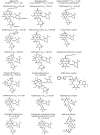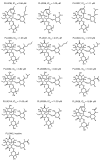Macrolides selectively inhibit mutant KCNJ5 potassium channels that cause aldosterone-producing adenoma
- PMID: 28604387
- PMCID: PMC5490757
- DOI: 10.1172/JCI91733
Macrolides selectively inhibit mutant KCNJ5 potassium channels that cause aldosterone-producing adenoma
Abstract
Aldosterone-producing adenomas (APAs) are benign tumors of the adrenal gland that constitutively produce the salt-retaining steroid hormone aldosterone and cause millions of cases of severe hypertension worldwide. Either of 2 somatic mutations in the potassium channel KCNJ5 (G151R and L168R, hereafter referred to as KCNJ5MUT) in adrenocortical cells account for half of APAs worldwide. These mutations alter channel selectivity to allow abnormal Na+ conductance, resulting in membrane depolarization, calcium influx, aldosterone production, and cell proliferation. Because APA diagnosis requires a difficult invasive procedure, patients often remain undiagnosed and inadequately treated. Inhibitors of KCNJ5MUT could allow noninvasive diagnosis and therapy of APAs carrying KCNJ5 mutations. Here, we developed a high-throughput screen for rescue of KCNJ5MUT-induced lethality and identified a series of macrolide antibiotics, including roxithromycin, that potently inhibit KCNJ5MUT, but not KCNJ5WT. Electrophysiology demonstrated direct KCNJ5MUT inhibition. In human aldosterone-producing adrenocortical cancer cell lines, roxithromycin inhibited KCNJ5MUT-induced induction of CYP11B2 (encoding aldosterone synthase) expression and aldosterone production. Further exploration of macrolides showed that KCNJ5MUT was similarly selectively inhibited by idremcinal, a macrolide motilin receptor agonist, and by synthesized macrolide derivatives lacking antibiotic or motilide activity. Macrolide-derived selective KCNJ5MUT inhibitors thus have the potential to advance the diagnosis and treatment of APAs harboring KCNJ5MUT.
Conflict of interest statement
Figures






References
-
- Lim SS, et al. A comparative risk assessment of burden of disease and injury attributable to 67 risk factors and risk factor clusters in 21 regions, 1990-2010: a systematic analysis for the Global Burden of Disease Study 2010. Lancet. 2012;380(9859):2224–2260. doi: 10.1016/S0140-6736(12)61766-8. - DOI - PMC - PubMed
MeSH terms
Substances
Grants and funding
LinkOut - more resources
Full Text Sources
Other Literature Sources
Medical

